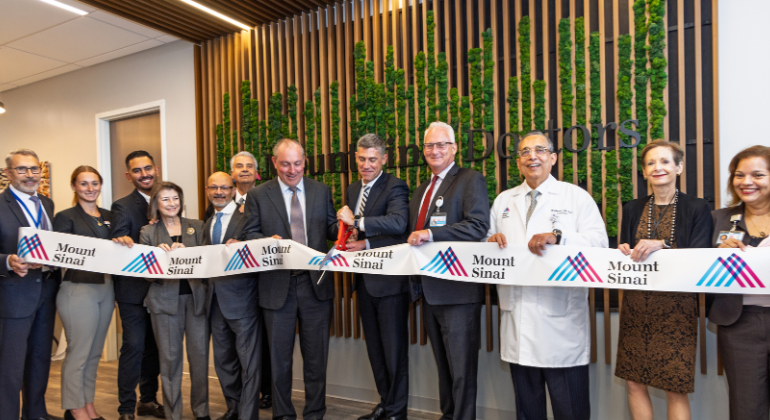Availability of Primary Care Physicians May Help Reduce Pediatric Surgeries
A recent study by researchers at Mount Sinai School of Medicine highlights the importance of access to pediatricians and family physicians.
Researchers at Mount Sinai School of Medicine have found that increased availability of primary care physicians may decrease the use of optional ear and throat surgeries in children. The researchers also found that children in areas with a high number of surgeons were much more likely to have these types of surgeries. The study was presented earlier this month at the Pediatric Academic Societies (PAS) meeting in Vancouver, British Columbia.
The key finding from New York State was that after taking into consideration the number of children and the number of surgical specialists in each region, more primary care providers in the region meant fewer surgeries. The researchers estimate that each primary care provider who cares for children reduced the number of surgeries by between 15 and 27 per year. In contrast, they estimated that after taking into account the number of children and the number of primary care doctors, each additional ear, nose, and throat (ENT) surgeon in a region was associated with an increase—an average of about 85 additional surgeries per surgeon—in that region. These findings offer one potential explanation for why there was a six fold difference between the region with the lowest number of surgeries (2.6 surgeries per 1000 children) and the highest (15.8 per 1000).
"Our findings suggest that adequacy of primary care in a community may reduce the number of surgeries for children and suggests a new outcome for future studies looking at the benefits of primary care," said Lawrence C. Kleinman, MD, MPH, the Vice Chair for Research and Education and Associate Professor of Health Evidence & Policy and Pediatrics at Mount Sinai School of Medicine and author of the study. “These data provide a clue that access to high quality primary care might prevent potentially unnecessary childhood surgeries.” Dr. Kleinman, a primary care pediatrician, asserted that these data are important to consider in the context of health care reforms that may impact either physician work force composition or physicians’ clinical practices.
Dr. Kleinman's team combined U.S. Census data with a database containing all New York State outpatient surgeries performed in 2006, as well as data on physician distribution in New York State, assembled by SUNY Albany. The team also integrated nationally representative data from across the country from 1995, 1996, and 2006, using the National Survey of Ambulatory Surgery, the National Medical Ambulatory Care Survey, the National Hospital Ambulatory Care Survey, and the Medical Expenditure Panel Survey & US Census data.
"There could be a number of explanations behind these numbers," continued Dr. Kleinman. “If there are limited pediatricians or family physicians in an area, then they may see more patients, and physicians may have less time to discuss the symptoms, risks, and parental concerns. Busier offices may lead to higher referral rates to surgeons, which may then lead to more surgeries. Another explanation could be that practicing in an environment with more surgeons could create a more surgery-oriented culture. These are all speculations, but highlight the importance of studying these findings further so that we avoid performing unnecessary surgeries.”
Dr. Kleinman’s team also showed that both the absolute and per capita number of tonsillectomies and adenoidectomies performed in the U.S. had doubled between 1996 and 2006. The increase could not explained by more outpatient visits to ENT surgeons, by an increase in pharyngitis/tonsillitis, or by a change in the reason for the surgeries. Dr. Kleinman noted that the use of this procedure had actually declined among children without any health insurance. Dr. Kleinman’s team had previously shown a similar pattern regarding an increase in the use of ear tubes from 1995-96 to 2006. In 2006 in the United States, nearly 670,000 children had tubes inserted into their ears, while more than 512,000 had tonsillectomy and adenoidectomy, making these the most common pediatric surgeries.
About The Mount Sinai Medical Center
The Mount Sinai Medical Center encompasses both The Mount Sinai Hospital and Mount Sinai School of Medicine. Established in 1968, Mount Sinai School of Medicine is one of few medical schools embedded in a hospital in the United States. It has more than 3,400 faculty in 32 departments and 15 institutes, and ranks among the top 20 medical schools both in National Institute of Health funding and by U.S. News & World Report. The school received the 2009 Spencer Foreman Award for Outstanding Community Service from the Association of American Medical Colleges.
The Mount Sinai Hospital, founded in 1852, is a 1,171-bed tertiary- and quaternary-care teaching facility and one of the nation’s oldest, largest and most-respected voluntary hospitals. In 2009, U.S. News & World Report ranked The Mount Sinai Hospital among the nation’s top 20 hospitals based on reputation, patient safety, and other patient-care factors. Nearly 60,000 people were treated at Mount Sinai as inpatients last year, and approximately 530,000 outpatient visits took place.
For more information, visit www.mountsinai.org.
About the Mount Sinai Health System
Mount Sinai Health System is one of the largest academic medical systems in the New York metro area, with 48,000 employees working across eight hospitals, more than 400 outpatient practices, more than 600 research and clinical labs, a school of nursing, and a leading school of medicine and graduate education. Mount Sinai advances health for all people, everywhere, by taking on the most complex health care challenges of our time—discovering and applying new scientific learning and knowledge; developing safer, more effective treatments; educating the next generation of medical leaders and innovators; and supporting local communities by delivering high-quality care to all who need it.
Through the integration of its hospitals, labs, and schools, Mount Sinai offers comprehensive health care solutions from birth through geriatrics, leveraging innovative approaches such as artificial intelligence and informatics while keeping patients’ medical and emotional needs at the center of all treatment. The Health System includes approximately 9,000 primary and specialty care physicians and 11 free-standing joint-venture centers throughout the five boroughs of New York City, Westchester, Long Island, and Florida. Hospitals within the System are consistently ranked by Newsweek’s® “The World’s Best Smart Hospitals, Best in State Hospitals, World Best Hospitals and Best Specialty Hospitals” and by U.S. News & World Report's® “Best Hospitals” and “Best Children’s Hospitals.” The Mount Sinai Hospital is on the U.S. News & World Report® “Best Hospitals” Honor Roll for 2024-2025.
For more information, visit https://www.mountsinai.org or find Mount Sinai on Facebook, Twitter and YouTube.

Mount Sinai Health System Expands Care in Staten Island
Nov 04, 2024 View All Press ReleasesMount Sinai Health Partners and Cigna Form New Collaborative Relationship
Aug 01, 2016 View All Press Releases